1947 BUGATTI TYPE 73C RACING CAR Monoposto coachwork by the Donington Collection Chassis No. 73002 Engine No. 2 Engine: four cylinder, in-line, 70mm bore by 95mm stroke, Miller-type barrel crank-case, alloy cylinder block with wet liners, detachable alloy cylinder head, twin camshafts operating four valves per cylinder, Bugatti supercharger, 1460cc, power output unknown but probably about 100bhp; Transmission: Bugatti multi-plate clutch, separate all synchromesh four speed and reverse gearbox similar to the pre-war Type 57S45 unit; Chassis: ladder frame similar to Type 59, wheelbase 2.4 meters, track 1.2 meters; Suspension: front axle beam suspended on semi-elliptic springs and damped by lever-arm friction shock-absorbers and constrained by a torque arm; wheels: 18 inch diameter wire spoked; Brakes: 350mm diameter alloy drums operated by twin cylinder hydraulics. Ettore Bugatti had founded his reputation as a manufacturer of high quality performance automobiles with his earliest four cylinder models before WWI. He introduced his first eight cylinder cars in 1922, and within ten years his entire range was of this configuration. However, whilst attending the Bugatti Owners' Club's International Prescott meeting in July 1939 Ettore's talented son Jean had intimated that a new four cylinder racing car was planned for the following season. Tragically this was destined not to materialize because within the next two weeks Jean was killed in a testing accident, and some three weeks later Europe was once again plunged into war. Bugatti, assisted by his designers Noel Domboy and Antoine Pichetto, spent the war years planning future models, one a 1,500cc car to be produced in a wide variety of forms ranging from a five-seater sedan to a single-seater racing car. By 1944 his plans for production were well advanced and he detailed his intentions in a letter dated February 1945 to Eric Giles, the Secretary of the B.O.C. The car was to have a supercharged 1500cc 16-valve engine, with a single overhead camshaft for the road cars but twin camshafts for the racing model. Further details were released once the war had ended. In a letter dated 27 September 1945 to Laurence Pomeroy, the editor of The Motor , Monsieur R.A. Bouchard of the Bugatti Company in Paris advised that the racing chassis was to be of ultra-low build, being derived from that of the pre-war 4.7 liter Type 59/50 B racing car, whilst its engine was to feature all-alloy construction with detachable wet cylinder liners, a detachable head (a first for Bugatti) and a five-bearing crankshaft. Transmission was to be by a four speed all synchromesh gearbox, and the car's total weight was not to exceed 600kg. No more than twenty examples were to be built in the old La Licorne factory in the Paris suburb of Levallois at a price of 500,000 French francs each. Five were to be delivered in April 1946, with five more during each of the next three months. Already fifteen French racing drivers had each lodged deposits of 25,000 francs, and English readers of The Motor were invited to order the remaining five planned. Inevitably this ambitious timetable floundered against the troubled post-war economic background when materials required for motor car construction were all in extremely short supply, and several orders were cancelled. Eventually a batch of five complete sets of parts for the racing model was produced, whilst an artist's impression of a planned aerodynamic sports saloon appeared in several Continental motor magazines and at least two of their chassis were produced. However Ettore Bugatti died in August 1947 before a single example of either type had been fully assembled. The 1947 Paris Motor Show was held at the Grand Palais in early October and Bugatti displayed on their stand an engineless example of their Type 73 sports chassis together with a standard single-cam Type 73 and a racing twin-cam Type 73C engine. One hopeful racing car buyer, Serge Pozzoli, who had placed his
1947 BUGATTI TYPE 73C RACING CAR Monoposto coachwork by the Donington Collection Chassis No. 73002 Engine No. 2 Engine: four cylinder, in-line, 70mm bore by 95mm stroke, Miller-type barrel crank-case, alloy cylinder block with wet liners, detachable alloy cylinder head, twin camshafts operating four valves per cylinder, Bugatti supercharger, 1460cc, power output unknown but probably about 100bhp; Transmission: Bugatti multi-plate clutch, separate all synchromesh four speed and reverse gearbox similar to the pre-war Type 57S45 unit; Chassis: ladder frame similar to Type 59, wheelbase 2.4 meters, track 1.2 meters; Suspension: front axle beam suspended on semi-elliptic springs and damped by lever-arm friction shock-absorbers and constrained by a torque arm; wheels: 18 inch diameter wire spoked; Brakes: 350mm diameter alloy drums operated by twin cylinder hydraulics. Ettore Bugatti had founded his reputation as a manufacturer of high quality performance automobiles with his earliest four cylinder models before WWI. He introduced his first eight cylinder cars in 1922, and within ten years his entire range was of this configuration. However, whilst attending the Bugatti Owners' Club's International Prescott meeting in July 1939 Ettore's talented son Jean had intimated that a new four cylinder racing car was planned for the following season. Tragically this was destined not to materialize because within the next two weeks Jean was killed in a testing accident, and some three weeks later Europe was once again plunged into war. Bugatti, assisted by his designers Noel Domboy and Antoine Pichetto, spent the war years planning future models, one a 1,500cc car to be produced in a wide variety of forms ranging from a five-seater sedan to a single-seater racing car. By 1944 his plans for production were well advanced and he detailed his intentions in a letter dated February 1945 to Eric Giles, the Secretary of the B.O.C. The car was to have a supercharged 1500cc 16-valve engine, with a single overhead camshaft for the road cars but twin camshafts for the racing model. Further details were released once the war had ended. In a letter dated 27 September 1945 to Laurence Pomeroy, the editor of The Motor , Monsieur R.A. Bouchard of the Bugatti Company in Paris advised that the racing chassis was to be of ultra-low build, being derived from that of the pre-war 4.7 liter Type 59/50 B racing car, whilst its engine was to feature all-alloy construction with detachable wet cylinder liners, a detachable head (a first for Bugatti) and a five-bearing crankshaft. Transmission was to be by a four speed all synchromesh gearbox, and the car's total weight was not to exceed 600kg. No more than twenty examples were to be built in the old La Licorne factory in the Paris suburb of Levallois at a price of 500,000 French francs each. Five were to be delivered in April 1946, with five more during each of the next three months. Already fifteen French racing drivers had each lodged deposits of 25,000 francs, and English readers of The Motor were invited to order the remaining five planned. Inevitably this ambitious timetable floundered against the troubled post-war economic background when materials required for motor car construction were all in extremely short supply, and several orders were cancelled. Eventually a batch of five complete sets of parts for the racing model was produced, whilst an artist's impression of a planned aerodynamic sports saloon appeared in several Continental motor magazines and at least two of their chassis were produced. However Ettore Bugatti died in August 1947 before a single example of either type had been fully assembled. The 1947 Paris Motor Show was held at the Grand Palais in early October and Bugatti displayed on their stand an engineless example of their Type 73 sports chassis together with a standard single-cam Type 73 and a racing twin-cam Type 73C engine. One hopeful racing car buyer, Serge Pozzoli, who had placed his
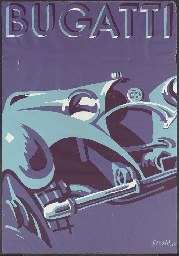
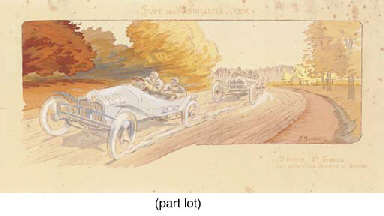
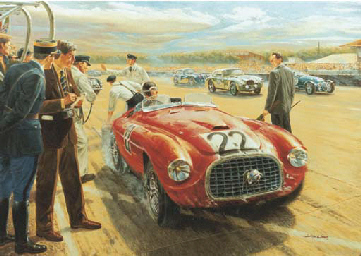
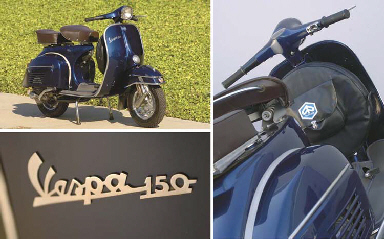
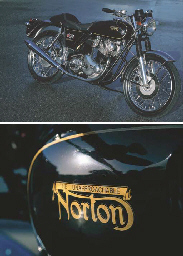
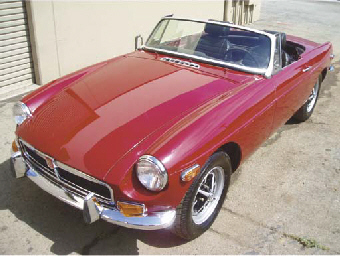
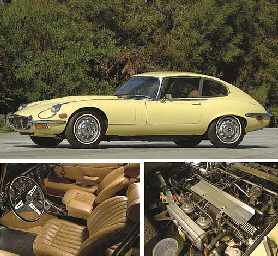
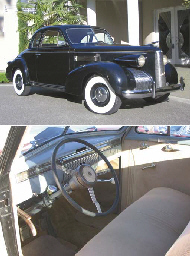
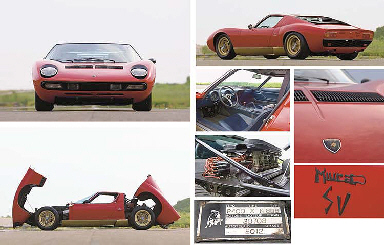
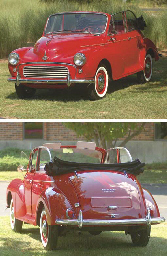
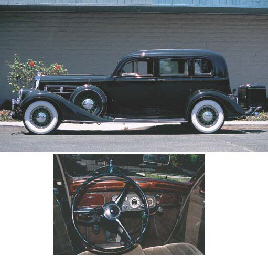
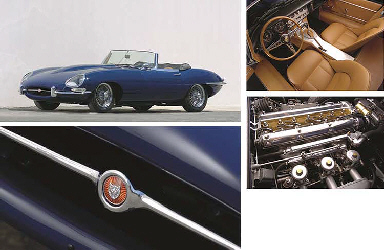
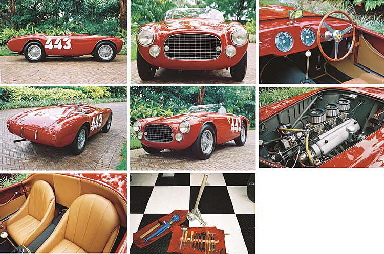
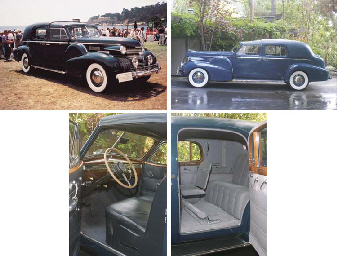
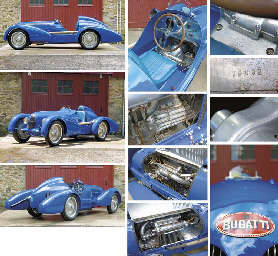
Try LotSearch and its premium features for 7 days - without any costs!
Be notified automatically about new items in upcoming auctions.
Create an alert